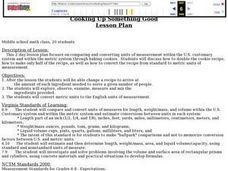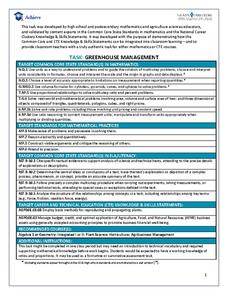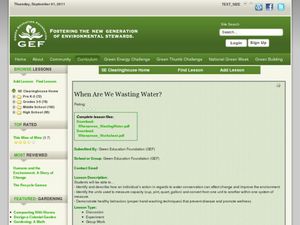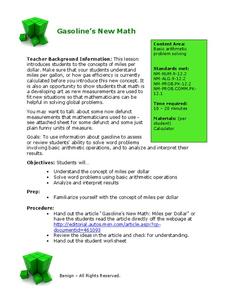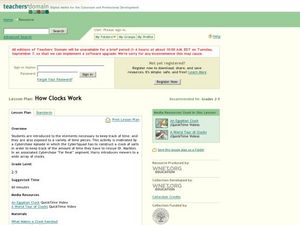Curated OER
It's All in the Measurements
Study customary measurements with your sixth graders. They will investigate linear and capacity measurements to then measure and convert linear and capacity units. Finally they will work in small groups to conduct experiments. Resources...
California Academy of Science
How Big is Big?
In a math or life science class, "mini-me" models are created with cardstock to reflect a 1:10 scale of students' bodies. Learners measure each others' heights with meter sticks, and then reduce the size by 10. After this exercise, they...
Curated OER
Recipe Conversions-Enrichment Worksheet
A recipe for Chocolate Chewies, a no-bake cookie, is provided, but the ingredients are not written in useable amounts. Your cooking class must first convert them into useable amounts before preparing the treat. The final product acts as...
Curated OER
Cooking Up Something Good
Students compare and convert units of measurement within the United States customary system and within the metric system by baking cookies. Students discuss how to double the cookie recipe, how to make only half of the recipe, and how to...
Curated OER
Converting Between Units
Upper graders practice using measurements by solving conversion problems. There are given different time or measurement increments and must convert them to a larger or smaller increment. They also utilize a calculator and conversion...
Intel
Metric Madness
Scholars learn about the metric system and produce a presentation on how to convert within the metric system. They then develop a brochure in support of legislation requiring the use of the metric system.
Curated OER
Eating Through the Metric System
Seventh graders convert measurements in recipes to metric measurements and prepare the food items. They create a metric measurement cookbook.
Achieve
Greenhouse Management
Who knew running a greenhouse required so much math? Amaze future mathematicians and farmers with the amount of unit conversions, ratio and proportional reasoning, and geometric applications involved by having them complete the...
Out-of-School Time Resource Center
Nutrition and Physical Activity
Emerging nutritionists explore what it means to be healthy. In the beginning of the unit, your class will examine the five food groups and learn how food gets from the farm to our plates. This leads into the investigation of...
Curated OER
What is Temperature and How Is It Measured?
Students complete activities to measure temperature. In this temperature lesson, students read Geoffrey Groundhog Predicts the Weather and make a KWL chart about predicting weather. Students discuss folklore about temperature and learn...
Curated OER
When Are We Wasting Water
Students study water conservation. In this water conservation lesson, students participate in a water conservation experiment. Students discover how to conserve water while washing their hands.
Curated OER
Let's Cook
Learners practice converting measurements into metrics. In groups, they translate a recipe from English into German and convert all measurements into metrics for the recipe. They examine the difference between United States and metric...
Curated OER
Using the Newspaper to Teach Division and Time Conversion
Students use classified ads to select a career. In this math instructional activity, students convert the listed salary to an hourly, yearly, weekly and monthly rate. Students explain the process they used to find the various rates.
Curated OER
Coastal Threat: A Story in Unit Conversions
Students convert measurements from one unit to another. In this math lesson, students study the environmental consequences of oil spills. They replicate an oil spill event by modeling and scaling.
Curated OER
What's In Crude Oil?
Middle schoolers investigate crude oil. In this crude oil instructional activity, students investigate fractional distillation and use this technique to separate two liquids.
Beyond Benign
Got Gas
How much gas does it take to drive around town? The class uses a variety of mathematical procedures to take a look at the use of gas for transportation. Class members use a different unit to determine the cost of driving a car as opposed...
Curated OER
Sorting
Students examine Library organization. In this logic lesson, students watch a Between the Lions episode and consider how the library has been organized. Students each list their 3 favorite book titles and how they would classify them....
Curated OER
Polymers and Products from Petroleum
Over four sessions, learners survey the production and use of polymers and petroleum products. First, they participate in a kinesthetic activity to demonstrate how polymers act, and review a list of common products made from...
Curated OER
"Use an Anemometer," said the Meteorologist
Students participate in an hands-on construction of an instrument to measure wind speed.
Curated OER
Efficiency
Fourth graders work cooperatively to investigate the efficiency of various household appliances. They share their findings in three to five minute oral presentations.
Curated OER
How to Figure Board Feet and Cost of a Board
Students investigate woodworking and converting lengths to cubic measurements. In this math conversions instructional activity, students examine the length of a piece of board, and its total area by using the formula for finding...
Curated OER
Money Makes the World Go Around
Learners convert currency from around the world. For this math lesson, students solve exchange rate problems using Google Earth. They complete a worksheet during the simulation.
Curated OER
Pumpkin Pie for All!
Students take a basic recipe for pumpkin pie that serves 8 and determine how many pies are necessary to feed their class. They convert the recipe measurements to make as many pies as they need and then make (and eat) the pies.
Curated OER
How Clocks Work
Students discover time pieces and complete telling time activities. In this time lesson, students complete a worksheet about what make a clock keep time. Students watch a video about time and clocks as well as a video about an Egyptian...



